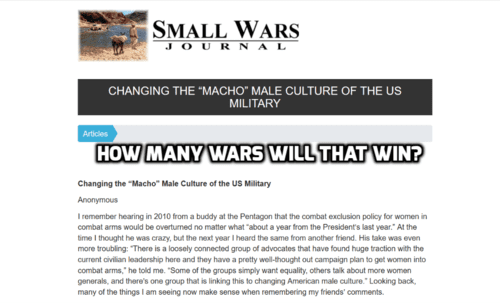


By Steve Sailer
11/24/2018
From Small Wars Journal:
Changing the “Macho” Male Culture of the US Military
October 2015, by Anonymous
I remember hearing in 2010 from a buddy at the Pentagon that the combat exclusion policy for women in combat arms would be overturned no matter what “about a year from the President’s last year.” At the time I thought he was crazy, but the next year I heard the same from another friend. His take was even more troubling: “There is a loosely connected group of advocates that have found huge traction with the current civilian leadership here and they have a pretty well-thought out campaign plan to get women into combat arms,” he told me. “Some of the groups simply want equality, others talk about more women generals, and there’s one group that is linking this to changing American male culture.” Looking back, many of the things I am seeing now make sense when remembering my friends’ comments.
Today I am privy to most of the plans that are currently in place to put women into combat arms. I have been told, again by acquaintances working at the Pentagon and at various headquarters around the US military, that all of the “experiments” that the services have been undergoing for some time now have been a sideshow. The decision had been made from the get-go. As one Female Engagement Team Program manager told many in Afghanistan in 2011, “the decision has already been made; we just need to talk about “the how” instead of “if”.”
This means that the Ranger School “experiment” was an experiment in name only. It was guaranteed from the beginning to graduate a woman and that graduation would be used as proof that the combat exclusion rule needed to go. This, of course, matches what every Army Command Sergeant Major (9) in 2011-2013 told me was said to them by high-level CSMs and General Officers while attending their pre-command courses: “women will be in combat arms and women will graduate Ranger School, if any of you has a problem with that, you need to get out of the military.” They reported that the Ranger Instructors at Ranger School were told the same thing. …
… In essence, the idea of many of these advocates is that the American male is a, mostly unconscious, misogynist, and that it comes from our culture: movies that hype physicality, combat, aggressiveness, and the treatment of women as objects. It also comes from our military: males dominate the services, are the only ones allowed in combat arms, and thus make up most of the higher ranks. The cure for all of this is simple: change the culture.
The “change the culture” movement has manifested itself in many ways and has taken on different efforts as well as groups that are loosely aligned towards fundamental change. … As one professor from a prominent campus told me recently, “It isn’t really about ending sexual assault; it’s about controlling people and changing behavior. Men have the advantage in almost every way, so we have to find ways to cut into that advantage. Making traditional male behavior something that is socially unacceptable will cut their advantage. We have to make it unacceptable for men to talk the way they talk now, act the way they act now, and interact the way they do with women now, and have traditionally.” Hyping sexual assault statistics, making women fearful of men, and building a system that finds men guilty until proven innocent are simply means to the greater end of “cutting male advantage.” …
For the military this means something similar. The military has also been accused of having a “rape culture” in the same manner as universities. Thus, combat arms positions are being cut while sexual harassment and assault counselors and advisers are being hired. Some see it as a cottage industry that requires a never-ending problem that has to be over-sold.
Homosexuals serving openly in the military was another effort to change the traditional male culture of the military- that traditional culture being one of heterosexuality (some call it “hyper heterosexuality”). It appears that since many homosexuals are either not serving in combat arms or not serving openly, this cultural change has not been as successful as the advocates were expecting …
The effort to change military culture also includes the effort to overturn the combat exclusion rule. This rule, as many advocates for overturning it have argued, is the strongest reason that men view women as less than men. According to some, it is the reason military men rape women, sexually harass them, and devalue them. It is the reason women get out of the service at higher rates, are injured more than men, have more PTSD issues, and score less on their PT tests.
… The Department of Defense is micromanaging the transition. …
The guidance from the Pentagon is very clear to commanders, if not always explicit in the orders (even though much of it IS explicit). … Women will be successful at combat arms schools. If they are not, leadership will be held accountable. Women will be successful at combat arms units. If they are not, leadership will be held accountable.
… The advocates do not believe, or do not care, that this could potentially negatively affect combat effectiveness. They assert that cohesion will not be an issue or they insist that “men will change.” The possibility that greater combat effectiveness actually might come from a “hyper macho” male culture is something the advocates refuse to acknowledge.